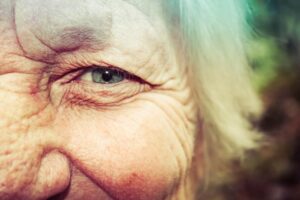Page Contents
Ageing can affect many aspects of your daily life that involve mobility, independence, and social engagement. As your health of the eye deteriorates, common problems may start to surface, that include poor vision, dryness of eyes, impaired colour perception, blurred vision, and even partial or complete blindness in some cases. Hence, proper eye care is important to start now before your eyesight get worse.

In this article, we look at the various signs of deterioration and potential eye conditions that develop as you age, how you can modify your living environment to cope with the conditions, and take precautions as early as you can.
What can happen to your eyes and vision as you grow older?
- Unable to focus and reading up-close
Presbyopia is a common condition starting around the age of 40. Up-close activities such are reading books or newspaper, reading mobile phones, or sewing can be quite challenging. Some people even experience headaches and eye strain. - Difficulty seeing in low light environment
Older adults take longer time to adjust and adapt in the dark than they used to be. This causes them to have difficulty navigating or driving at night. - Sensitive to glare
Similarly, older adults usually have shrinking pupil size, this causes them to receive lesser light as normal people. Therefore, they become more sensitive to glare. - Blending objects into backgrounds
Many elderly people experience difficulty to distinguish objects from backgrounds of similar colour or shade. This is due to the loss of contrast and depth sensitivity. - Dry eyes
Older adults tend to produce less tears due to polypharmacy, androgen deficiency, reduced blinking, and oxidative stress. Dry eye is also rather common among women who have gone through menopause. - Red, swollen eyelids
Blepharitis is the inflammation of the eyelid due to hormonal changes as we age. Symptoms of blepharitis include red or swollen eyes, crust around the eyelashes, or soreness. - Presence of floaters
As we age, the vitreous (jelly-like substance filling the middle of the eye) become thicken or shrink. The formation of tiny gel clumps stick together and cast shadows on our retina causing floaters in our vision. - Flashes of light
Flashes can appear when the vitreous gel tugs and creates friction on the retina. This tugging and friction can cause retinal tear and detachment if there is no timely intervention.
Common eye conditions associated with ageing
The 4 leading causes of blindness and poor vision are age-related macular degeneration (AMD), cataract, diabetic retinopathy, and glaucoma. Symptoms of these conditions often go unnoticed until the condition worsen. Getting regular eye examination is the only way to capture the condition early and protect yourself from vision loss.
- Age-related macular degeneration (AMD)
AMD is a common eye disease that blur your central vision. The symptoms is rarely noticeable during early stages of the disease. - Cataracts
Older adults commonly develop cataracts. It is a condition where the proteins in your lens break down and cause vision blurry, hazy or less colourful, making it difficult to see. - Diabetic retinopathy
Diabetic retinopathy is another leading cause of vision loss among adults with diabetes. Uncontrolled high levels of blood glucose can decreases the elasticity and damage the blood vessels in the retina. - Glaucoma
Glaucoma can occur at any age but is more common in older adults. Glaucoma is the damage of the optic nerve and can lead to vision loss if not treated early.
Home design and improvement for older adults
With the deteriorating eyesight, many elderly people are experiencing difficulty in navigating their home environment, causing unnecessary injuries. Their challenges mainly attributed to the inability to tell the differences between colours, contrast, and light intensity.
Colours
- Ageing causes eyes to lose the ability to differentiate pale colour tones, making light tones appear white. Some elderly also unable to differentiate shades of cooler colours (e.g. blue and purple), these may be perceived as grey.
- Older adults with colour deficiencies are better in perceiving bright and warm colours, such as reds and oranges.
Contrast
- Many elderly people also lose the ability to judge depth and distance. Older adults with these conditions may find complex patterns confusing and distracting. For example, bold stripes may look like they are moving, and a pattern of white dots on a dark background may look like dirt that need to be cleaned up.
- Often, just by using high colour contrast in different parts of the home environment, it can help them to discern one object from another.
Lighting
- Senior people also are more sensitive to glare and light. They lose the ability to see clearly in low light environment. When transiting from a well-lit area to a darker area, they may take longer to adjust and focus.
- Such problems in adjusting between light and dark can make driving unsafe, especially at night, in the rain, and drive through tunnels.
- Duller or non-reflective sheen such as flat or matte finishes are the safest environments for the ageing.
To make home environment more conducive for elderly, you can incorporate colours and contrasts to highlight elements in the room, make them more conspicuous, and facilitate navigation and orientation. Some examples are such as, painting doors, frames, and light switches in strong contrast from the walls so they are easier to see, applying texture to different surfaces to help them navigate better.
How to care for your eyes?
Eye examination
- Routine eye exams are important for ensuring your overall eye health. High blood pressure, high cholesterol, vitamin deficiencies, and several diseases can be detected through the eye before any symptoms surface. Through eye exams, optometrist can also identify other health problems such as diabetes, dementia, or stroke.

- It is recommended that all adults should get at least a baseline eye examination by age 40. At the age of 65 and above, the frequency to visit optometrist should increase to every one to two years. Regular eye examinations allows your ophthalmologist to identify potential problems early. The earlier a problem is detected, the higher chance that treatment will be successful with minimal or no complications.
Family history
- Aside routine eye examination, knowing your family history is important to identify your risk factors and take precautions for serious eye conditions. Discuss family history, ethnicity, age, and other factors with your ophthalmologist.
Healthy diet and lifestyle
- As advocated in previous blog articles, healthy living is essential for longevity and good quality of life. Healthy habits like exercising, sleeping well, stress management, quit smoking and drinking, etc. can eventually help to prevent conditions like obesity, diabetes, and heart disease.
- Eating foods rich in vitamins C and E, zinc, lutein, zeaxanthin, and omega-3 fatty acids can reduce the risk of developing AMD and cataract.
Other common eye protection strategies
- To avoid glare, wear a shade or sunglasses outdoor.
- Adjust home lighting to a comfortable level.
- Use eye drops to mitigate dryness of eyes.
- Use matte screen filter or blue light filter on digital devices.

Conclusion
Deteriorated eyesight and various eye conditions can greatly affect your safety and quality of life. Not being able to see clearly or estimate the distance and depth can cause you to lose balance and fall. Sensitive to glare will cause headache and discomfort. Not able to see in low light environment is a common safety risk among older adults.
If you are suffering of any of these (and many other) eye condition, you should seek medical consultation as early as possible. Early detection allows more options of treatments and increase your chances of recovery.
